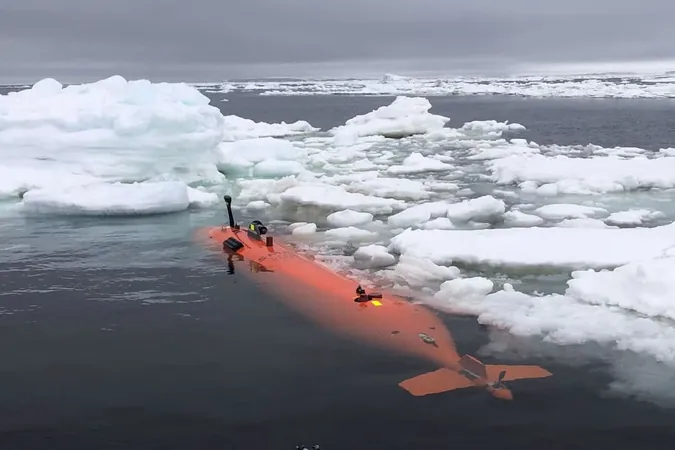
Mysterious Disappearance of Advanced Submersible ‘Ran’ Raises Alarm Over Antarctic Research
2024-12-07
Author: Sarah
In an astonishing mission in 2022, a team of international scientists made headlines as they set out to explore the largely uncharted depths under the Dotson Ice Shelf in West Antarctica. Their secret weapon was a 20-foot-long autonomous underwater vehicle (AUV) known as "Ran." This state-of-the-art submersible was equipped to traverse difficult underwater terrains and collect vital data on the ice shelf’s structure and melting patterns.
Over the course of 27 days, Ran covered a staggering 600 miles, including a perilous 10-mile journey into the ice shelf cavity. Utilizing cutting-edge multibeam sonar technology, the submersible managed to map around 50 square miles of ice, unearthing complex underwater topographies that far exceeded the researchers' expectations.
Remarkable Discoveries
The findings were transformative and revealed a host of previously unseen features beneath the ice, including:
- Tear-drop shaped formations on the ice shelf's underside. - Intricate erosion patterns on icy plateaus. - Notable disparities in melting rates across the western and eastern sections of the ice shelf.
These discoveries provided critical insight into the mechanisms of ice shelf melting and their potential repercussions for global sea levels. As the urgency of climate change becomes more palpable, this research is paramount for understanding its impact on fragile polar ecosystems.
The Enigma of Ran's Disappearance
However, following the success of the initial mission, the atmosphere shifted drastically during a follow-up expedition in early 2024. The research team, led by scientist Anna Wåhlin, was met with mounting anxiety when Ran did not surface at the designated meeting point.
The mysterious vanishing of this high-tech submersible has left researchers in a state of bewilderment. Multiple theories have emerged regarding its fate:
- Ran may have encountered an unexpected underwater terrain where it became stuck. - Curious seals might have interfered with its navigation systems. - Technical failures could have led to a loss of direction and communication.
The loss of Ran is a considerable blow to Antarctic research, depriving scientists of a unique tool tailored to navigate challenging underwater environments and gather crucial data.
Ripple Effects on Climate Science and Research
Ran’s disappearance emphasizes the hurdles faced by scientists seeking to comprehend climate change in polar regions. As global temperatures rise, understanding how ice shelves behave is more vital than ever. These floating ice formations serve as crucial barriers, preventing land-based glaciers from flowing rapidly into the ocean, exacerbating sea-level rise.
Initial data collected by Ran revealed intricate details about the melting patterns of the Dotson Ice Shelf. Researchers identified a significant contributor to these variations: a phenomenon known as modified Circumpolar Deep Water (mCDW). This mixing process, involving waters from the Pacific and Indian Oceans, has dramatic effects on the base of the ice.
While the loss of Ran presents a challenge, it also spotlights the necessity for innovative developments in underwater exploration technologies. As scientists work to understand our planet and its complexities, the advancement of more resilient submersibles is essential. Moreover, similar technologies could potentially be deployed in extraterrestrial explorations, such as those targeting the icy moons of Jupiter and Saturn, where the search for life continues fervently.
Antarctic Exploration: The Road Ahead
Despite the setback from Ran’s disappearance, scientists remain steadfast in their commitment to unveil Antarctica’s secrets. The invaluable insights gained from the 2022 mission proactively contribute to understanding underlying processes and anomalies of these immense ice structures. To facilitate future expeditions, researchers are pursuing the creation of new submersibles and enhancing current technologies to ensure security and productivity.
The pursuit of knowledge beneath Antarctic waters transcends mere scientific intrigue; it holds extraordinary implications for our grasp of climate change and its worldwide impacts. As we advance our exploratory efforts, it is also critical to balance scientific innovation with environmental stewardship. Protecting these pristine environments must remain a priority in ongoing research efforts.
The vanishing of Ran serves as a stark reminder of the perils inherent in exploring extreme environments. Yet, such challenges often catalyze advancements not only in technology but also in our collective understanding of our world. Like the extensive Mars exploration undertaken by the Curiosity Rover, these scientific quests embody human resilience and determination.
As researchers forge ahead into the icy depths of Antarctica, the legacy of Ran and its pioneering discoveries will undoubtedly fuel the curiosity of future explorers, underscoring the enduring quest to comprehend our planet’s polar landscapes in an era defined by climate uncertainty.

 Brasil (PT)
Brasil (PT)
 Canada (EN)
Canada (EN)
 Chile (ES)
Chile (ES)
 España (ES)
España (ES)
 France (FR)
France (FR)
 Hong Kong (EN)
Hong Kong (EN)
 Italia (IT)
Italia (IT)
 日本 (JA)
日本 (JA)
 Magyarország (HU)
Magyarország (HU)
 Norge (NO)
Norge (NO)
 Polska (PL)
Polska (PL)
 Schweiz (DE)
Schweiz (DE)
 Singapore (EN)
Singapore (EN)
 Sverige (SV)
Sverige (SV)
 Suomi (FI)
Suomi (FI)
 Türkiye (TR)
Türkiye (TR)